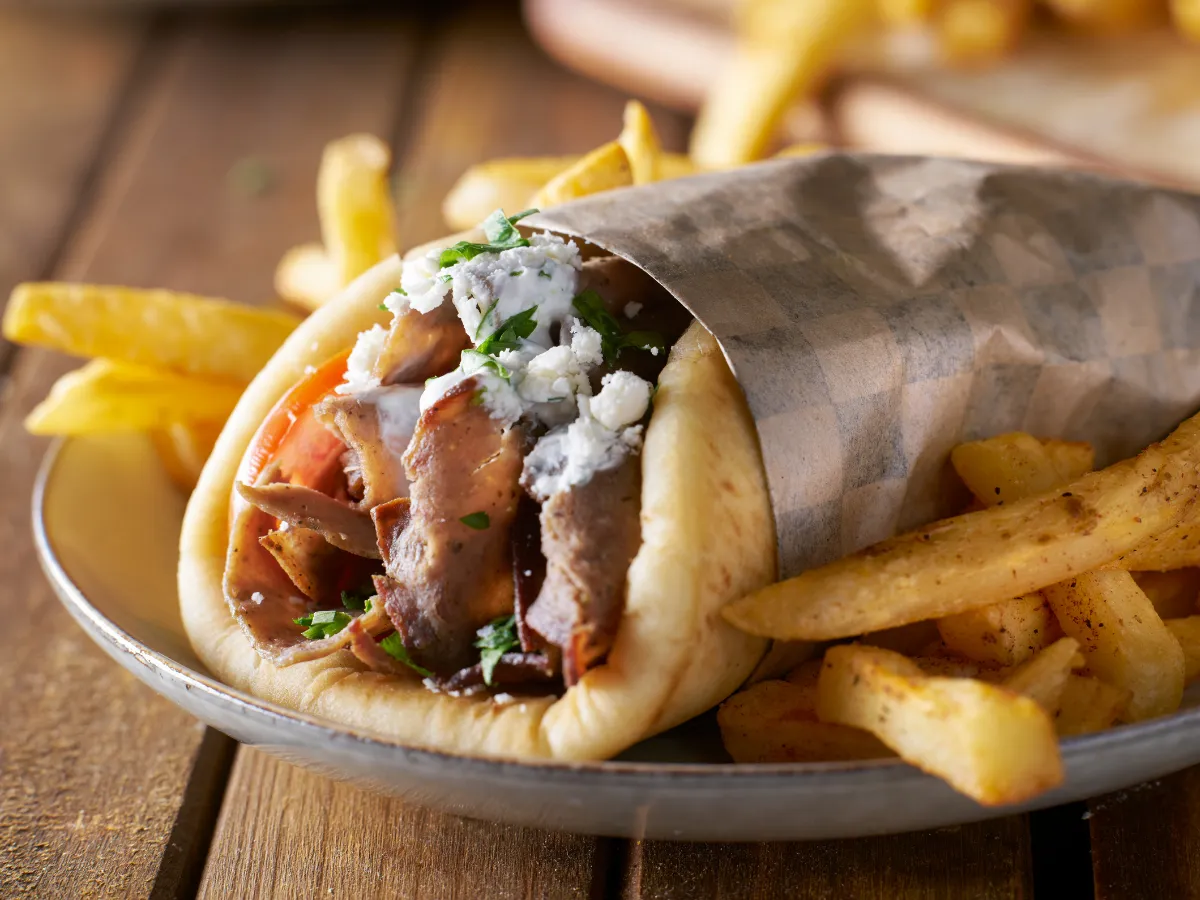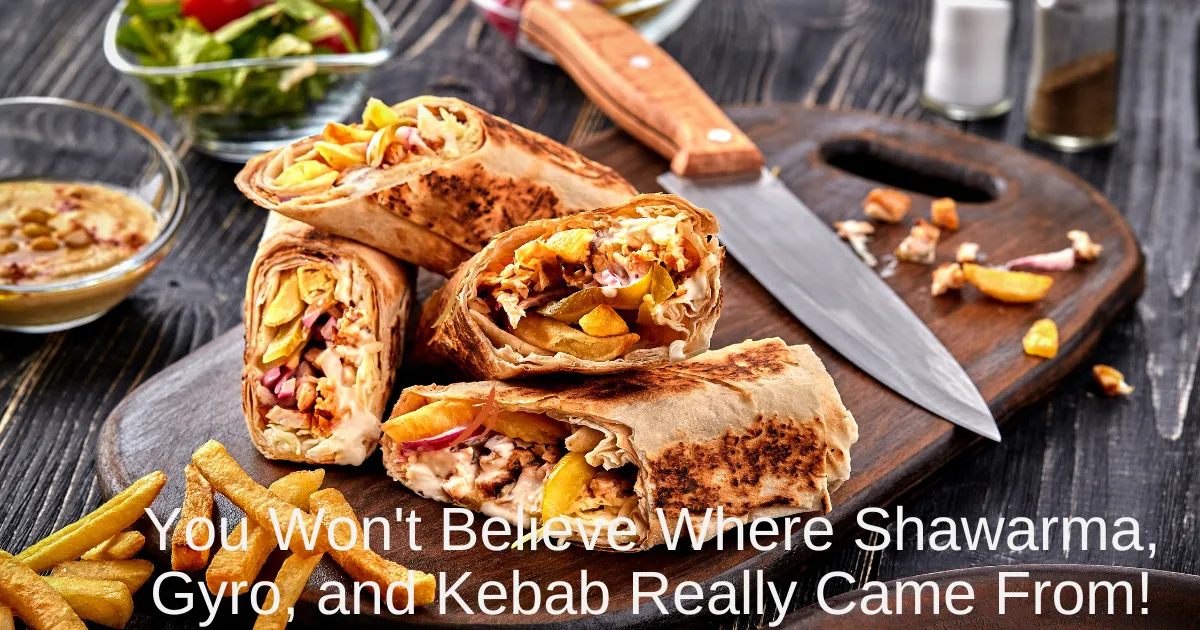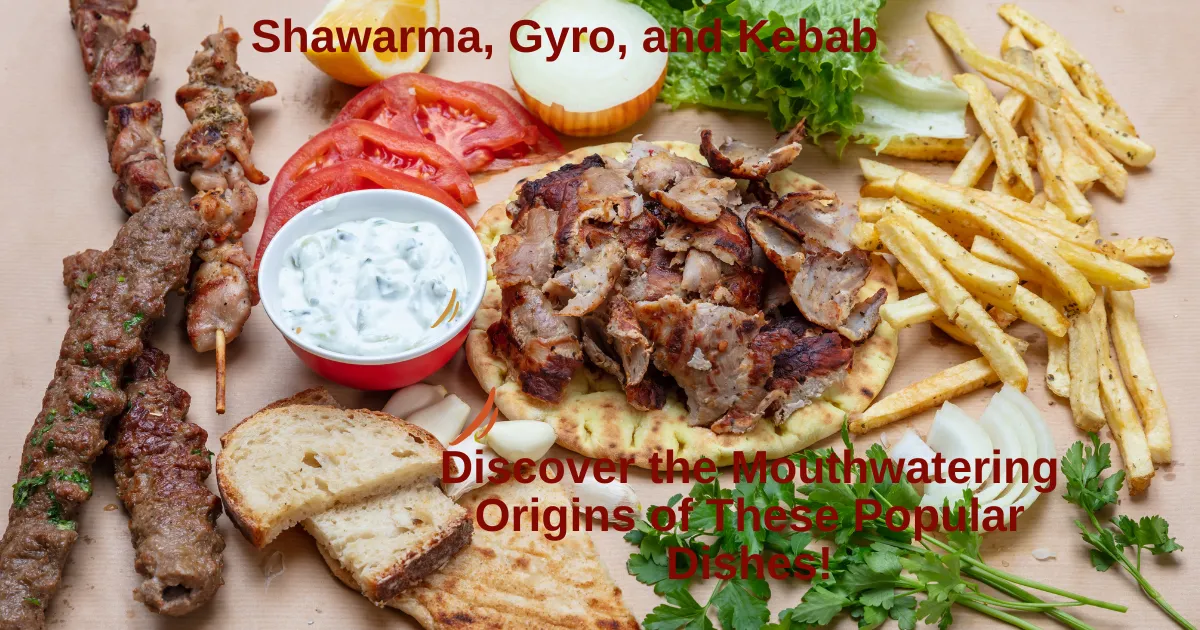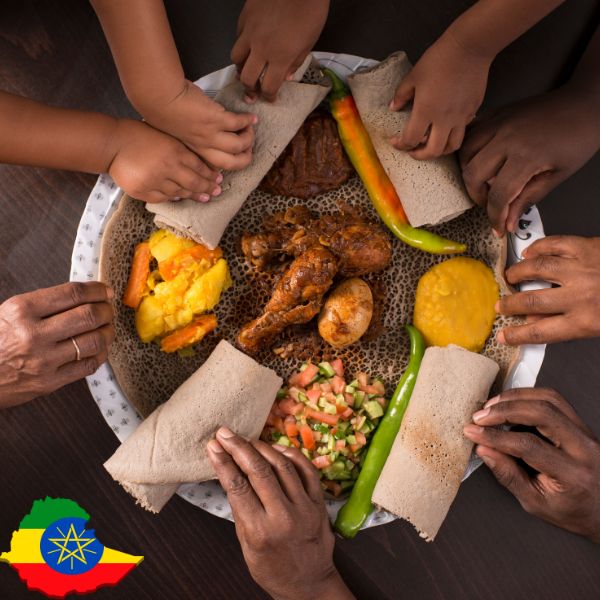Shawarma vs. gyro – Are you a fan of Mediterranean cuisine? Do you find yourself torn between two delicious options: shawarma and gyro? Well, you’re not alone. These two mouthwatering dishes have captured the hearts and stomachs of food enthusiasts worldwide, sparking a debate that remains unresolved.
In this article, we will delve into the origins, ingredients, and distinctive flavors of shawarma and gyro. Whether you’re a meat lover or a vegetarian, there’s much to consider when choosing between these delectable treats.
So, prepare to embark on a culinary journey as we compare and contrast shawarma and gyro in the ultimate battle for your heart and stomach.
Let’s explore the distinct qualities and flavors that make these dishes so beloved worldwide.
While all three dishes share similarities, they each have unique characteristics and origins. It’s time to delve into the world of Mediterranean street food and explore the nuances that distinguish these dishes.
So, whether you’re a food enthusiast looking to expand your culinary knowledge or want to order a suitable dish at your favorite Mediterranean restaurant, this article is for you. Prepare to tantalize your taste buds and discover the differences between shawarma, gyro, and kebab.
By the end of this article, you’ll be able to distinguish between shawarma, gyro, and kebab and gain a deeper appreciation for the cultural significance and flavors that make each dish so unique. So, let’s embark on this delicious journey and unravel the mysteries of shawarma, gyro, and kebab.
Whether you’re a fan of one or all three, get ready to satisfy your cravings and become an expert in Mediterranean street food.
Shawarma, gyro (or giro), and kebab are popular dishes that originated in different parts of the world. While they share some similarities, they differ in their preparation, ingredients, and cultural influences.
Shawarma vs. Gyro vs. Kebab – What’s the Difference?
Origin: Shawarma is a Middle Eastern dish believed to have originated in the Levant region.
Preparation: Shawarma typically consists of marinated meat (such as chicken, beef, or lamb) slowly roasted on a vertical spit or rotisserie. The meat is thinly sliced and served in pita bread or flatbread, often accompanied by vegetables, tahini sauce, and pickles.
Cultural Influence: Shawarma is commonly associated with Middle Eastern and Mediterranean cuisines and is popular in countries like Lebanon, Syria, Turkey, and Israel.
Calorie Content: A typical shawarma sandwich, made with chicken or beef, can range from approximately 400 to 600 calories, depending on its size and ingredients. This estimate includes the meat, bread, and standard toppings such as tahini sauce, vegetables, and pickles.
Components: Shawarma typically consists of thinly sliced, marinated meat (usually chicken, beef, or lamb) cooked on a vertical rotisserie. It is commonly served in pita bread or flatbread, accompanied by various components such as tahini sauce (a sesame paste-based sauce), vegetables like tomatoes and cucumbers, and pickles.
Glorious Gyro: A Taste of Greece
Origin: The gyro is a Greek dish with roots in the Mediterranean region.
Preparation: Gyro is prepared similarly to shawarma, with meat (usually pork, chicken, or lamb) cooked on a vertical rotisserie. The beef is thinly sliced and typically served on pita bread with tomatoes, onions, tzatziki sauce, and sometimes French fries.
Cultural Influence: Gyro is an iconic Greek street food widely enjoyed in Greek cuisine. It has also gained popularity in various other countries and is a standard fast food option in many places.
Calorie Content: The calorie content of a gyro can vary depending on the type of meat and the specific ingredients used. A gyro sandwich can range from approximately 500 to 800 calories. This estimate includes the meat, bread, and typical toppings such as tzatziki sauce, tomatoes, onions, and occasionally French fries.
Components: A gyro typically consists of thinly sliced meat (pork, chicken, or lamb) cooked on a vertical rotisserie. It is often served in a pita bread pocket with ingredients such as tzatziki sauce (a yogurt and cucumber-based sauce), tomatoes, onions, and occasionally French fries.
Kebab Sensations: Grilled Delicacies
Origin: The kebab has a broader origin, with variations found in many cultures, including Middle Eastern, South Asian, and Mediterranean.
Preparation: Kebabs are a variety of meat dishes typically skewered and grilled. The meat can be marinated or seasoned before cooking, often accompanied by vegetables such as onions, bell peppers, or tomatoes. Kebabs can be made with different types of meat, including beef, lamb, chicken, or even seafood.
Cultural Influence: Kebabs are renowned across various cultures and countries, including Iran, Turkey, India, Pakistan, and Afghanistan. Different regions have their unique styles and flavors of kebabs.
Calorie Content: The calorie content of a kebab can vary significantly depending on the type of meat, cooking method, and accompanying ingredients. A single kebab skewer can range from approximately 200 to 400 calories. This estimate includes the meat and any accompanying vegetables or marinades.
Components: Kebabs come in various forms and can include different meats (such as beef, lamb, chicken, or seafood) that are marinated or seasoned, then skewered and grilled. The ingredients can vary, but kebabs often include a combination of meat, onions, bell peppers, tomatoes, and various spices or marinades.
When considering these dishes as part of a diet, it’s essential to be mindful of portion sizes, the choice of lean meats, and the amount of added sauces or dressings. Additionally, opting for whole wheat or lower-calorie bread options and increasing the proportion of vegetables can help make these dishes more diet-friendly.
| Item | Origin & Cultural Background | Typical Meats | Signature Seasonings | Serving Style | Signature Sauces/Toppings | Texture & Flavor Profile | Approx. Nutrition (Typical Street-Food Serving)* |
|---|---|---|---|---|---|---|---|
| Shawarma | Levant/Middle East; evolved from Ottoman döner. A modern staple of Arab street food and diaspora eateries. | Chicken, lamb, beef (stacked on vertical spit) | Cumin, coriander, turmeric, paprika, cardamom, garlic, lemon | Rolled in pita/flatbread or plated over rice with salads | Tahini or garlic sauce (toum), pickles, tomatoes, parsley | Juicy, warmly spiced, tangy; charred edges from the spit |
|
| Gyro | Greece; also derived from döner. Iconic Greek fast food with strong regional pride. | Pork (traditional in Greece) or chicken; beef/lamb blends abroad | Oregano, thyme, garlic, marjoram, black pepper | Wrapped in pita with fries (often), or as a plate | Tzatziki, tomatoes, onions; sometimes fries inside the wrap | Herby, garlicky, creamy-cool contrast from tzatziki; hearty |
|
| Kebab | Widespread across the Middle East, Turkey, South Asia. Many forms: skewered (shish), ground (seekh/kofta), or shaved (döner). | Lamb, beef, chicken; sometimes mixed with herbs/spices | Varies by style; common: cumin, sumac, paprika, chili, garlic | Skewers with rice/flatbread, salads; or wrapped as dürüm/doner | Yogurt, chili sauce, sumac onions, herbs; regional sides | From smoky and char-grilled (skewers) to rich and savory (döner) |
|
| *Estimates for a typical street-food wrap/plate with bread and sauces. Values vary by portion size, meat-to-bread ratio, cooking fat, and toppings. | |||||||
Healthier Alternatives To The Traditional Sauces And Dressings Used In These Dishes
If you’re looking for healthier alternatives to the traditional sauces and dressings used in shawarma, gyro, and kebab dishes, here are some options:
Lighter Yogurt-Based Sauces: Instead of traditional mayonnaise or creamy sauces, you can opt for lighter yogurt-based sauces. For example:
Tzatziki Sauce: To make a healthier tzatziki sauce, combine Greek yogurt, grated cucumber, minced garlic, lemon juice, and dill. This combination offers a refreshing flavor without the high-fat content.
Yogurt-Herb Sauce: Mix plain yogurt with chopped fresh herbs like mint, cilantro, parsley, lemon juice, and a pinch of salt. This sauce adds a tangy and herbaceous touch.
Tahini-Based Dressings: While tahini sauce is commonly used in shawarma, you can make a lighter version by adjusting the ingredients and quantities. Here’s an example:
Light Tahini Dressing: Combine tahini, lemon juice, water, minced garlic, and salt. Adjust the consistency by adding more water as needed. This dressing retains the nutty flavor of tahini but with fewer calories.
Instead of heavy sauces, use fresh salsas or chutneys to add flavor and moisture.
These options are typically lower in calories and provide a burst of freshness. Some ideas include:
Tomato-Cucumber Salsa: Dice tomatoes and cucumbers and mix them with chopped onions, cilantro, lime juice, and a pinch of salt.
Mint-Coriander Chutney: Blend fresh mint leaves, coriander leaves, green chili, garlic, lemon juice, and a little water until smooth. Adjust the spiciness to your preference.
Citrus Vinaigrettes: Light and tangy citrus-based vinaigrettes can be a healthier alternative to heavy dressings. Consider making a simple dressing with lemon or lime juice, olive oil, Dijon mustard, and a touch of honey or maple syrup for a hint of sweetness.
Hot Sauce or Spicy Condiments: If you enjoy some heat, adding a dash of hot sauce or spicy condiments can provide flavor without excessive calories. Look for options that are low in added sugars and sodium.
Shawarma and Gyro Differences
While both shawarma and gyro are delicious and involve meat cooked on a vertical rotisserie and often served in pita bread, they have distinct origins, seasonings, and traditional accompaniments:
Origin:
- Shawarma Originates from the Middle East, specifically the Levant region (Eastern Mediterranean). The name comes from the Arabic word “shawarma,” which means “turning.”
- Gyro is a Greek dish. The name “gyro” (pronounced “YEE-roh”) comes from the Greek word for “turn.”
Meat:
- Shawarma: Can be made from various thinly sliced marinated meats stacked on a vertical spit, including lamb, beef, chicken, and turkey, individually or in combination.
- Gyro: Traditionally made from a combination of ground lamb and beef, seasoned and formed into a large cone, cooked on a vertical rotisserie. While less traditional, you can find gyros made with pork, chicken, or beef.
Seasoning:
- Shawarma: Typically features bold and warm Middle Eastern spices. Typical seasonings include cumin, coriander, turmeric, paprika, cardamom, cinnamon, cloves, and sometimes chili powder. The marinade often includes lemon juice, vinegar, and garlic.
- Gyro: Has a more herbal and Mediterranean flavor profile. Typical seasonings include oregano, thyme, rosemary, garlic, and sometimes marjoram.
Sauce:
- Shawarma is often served with a tahini-based sauce, garlic sauce (toum), or hummus. Pickled vegetables like turnips and cucumbers are also common additions.
- Gyro: Is traditionally served with tzatziki sauce, a cool and tangy yogurt-based sauce with cucumber, garlic, and dill.
Serving Style:
- Shawarma is typically served in a pita or wrap, often with lettuce, tomatoes, onions, pickles, and the specific sauce.
- Gyro is traditionally served on grilled pita bread, which is often thicker and softer than the pita used for shawarma. Common fillings include tomatoes, onions, and the signature tzatziki sauce. Sometimes, lettuce and feta cheese are added.
In summary:
| Feature | Shawarma (Middle East) | Gyro (Greece) |
|---|---|---|
| Origin | Middle East (Levant) | Greece |
| Meat | Lamb, beef, chicken, turkey (marinated slices) | Ground lamb and beef (formed cone), sometimes pork/chicken/beef |
| Seasoning | Bold, warm Middle Eastern spices (cumin, coriander, turmeric, etc.) | Herbal, Mediterranean spices (oregano, thyme, rosemary, etc.) |
| Sauce | Tahini-based, garlic sauce (toum), hummus | Tzatziki (yogurt, cucumber, garlic, dill) |
| Serving | Pita or wrap with various vegetables & pickles | Grilled pita with tomatoes, onions, tzatziki (sometimes lettuce, feta) |







August 24, 2023 at 9:43 amInMotion Hosting: InMotion Hosting offers fast and reliable hosting services with excellent customer support. They provide a variety of hosting options, including business hosting, VPS hosting, and dedicated servers.
Bluehost: It is one of the most popular hosting providers, recommended by WordPress. They offer a user-friendly interface, excellent uptime, and 24/7 customer support.
August 25, 2023 at 3:56 pm[…] Shawarma vs. Gyro: Wrapping Up the Ultimate Food Rivalry […]